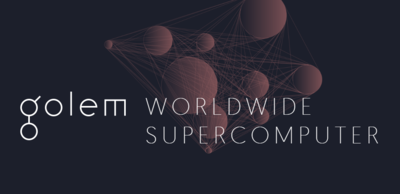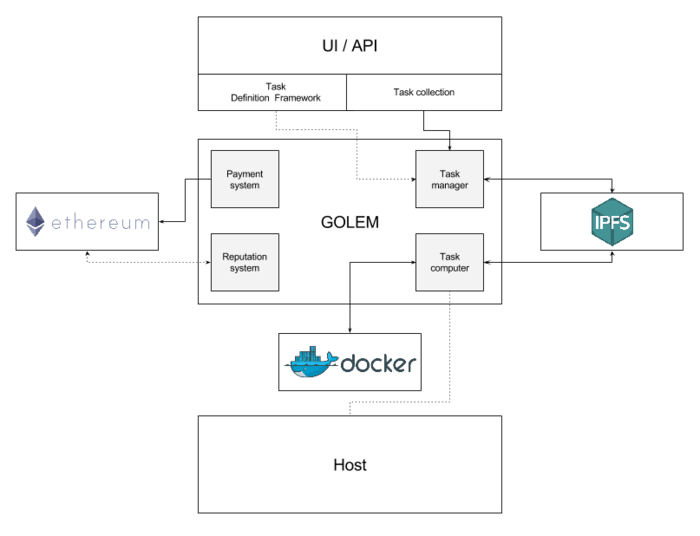Golem Worldwide Supercomputer

Golem is a worldwide, decentralized supercomputer that combines the computing power of every machine on its network. In the Golem ecosystem, you can loan out your computer’s spare resources to others who need the additional power to perform complex computations and tasks. Following the same trend that led to Uber and Airbnb, this is a solid way to make some extra money with your unused and/or underused resources.
On the flip side, you can rent computing power from the network to perform or even just speed up tasks that your computer has trouble handling. This is ideal if you routinely perform intensive calculations for activities like natural language processing (NLP), artificial intelligence (AI), or even machine learning for DNA exploration. However, the Golem team is first focusing on CGI rendering – an area riddled with expenses and long wait times.
Contents
How does Golem work?
Let’s walk through the entire process of a requestor (party who needs to perform a computing task) using the Golem network.
To keep it simple, let’s assume that the requestor’s task is the same class as one of the task templates that Golem provides. If it wasn’t, the requestor would have to write his/her own code for the task using the task definition framework. However, this option isn’t available in the first two releases – Brass and Clay. Performing tasks in a different class than the task templates will be available in the third release, Stone.

- See also GNT or Golem Network Token
Blender and Luxrender are the only two task templates available in the first Golem version, Brass. Eventually, the set of task templates will turn into the Golem Shop where you can add and use new templates on the network.
Back to our example, though. After the requestor chooses a template, the task is added to the task manager, and the network receives the information about the task.
A provider (party providing the computing power) receives all the broadcasted task offers and selects the best one. In doing so, it also checks the reputation of each node broadcasting the tasks and rejects ones with a poor reputation. When a provider finds a suitable offer, it sends a price and its computing power information to the requestor. In return, the requestor verifies that the provider has a high enough reputation to work with[1].
If all is kosher, the provider receives the appropriate resources via IPFS and begins the computation on the task computer. Once the task is complete, it sends the results to the requestor back through the IPFS network.
Then, the task manager passes the information to the appropriate node to verify the results. The requester may decide to send it to multiple nodes for redundant verification.
Finally, the payment system is notified through an Ethereum smart contract, and funds move from requestor to provider. If the provider sends accurate results and the requestor pays on time, both parties will see an increase in their reputation.
Additional Features
Outside of the scenario outlined above, Golem contains two other related features.
- Application Registry – An Ethereum smart contract for developers to publish their own Golem applications. This makes it easier for developers to find users and requestors to find the tools they’re looking for.
- Transaction Framework – A set of requirements that a developer must follow when implementing a transaction model for their self-made Golem application[2].
Golem News
Golem coin, not to be confused with the beast of Jewish folklore, was among one of the only cryptocurrencies that continued seeing gains on Wednesday after Tuesday’s bullish market. With a market cap of $5.19 million, Golem is ranked 35 of the cryptocurrency list. Also known as the “AirBnB of computing,” Golem is a global, open-source, decentralized supercomputer that can be accessed by anyone. In other words, it provides a market for putting your computer’s excess CPU power to use for other people. That way, you could arguably make money while browsing your computer. Their ecosystem enables users and applications to rent out cycles of other users’ machines. Any user, from a single PC owner to a large data center can share resources through Golem and get paid in Golem Network Tokens, or GNT.
Golem utilizes an Ethereum-based transaction system to settle payments. In fact, Golem CEO, Julian Zawistowski, believes Ethereum is by far the most promising blockchain platform, and that Golem could only be possible thanks to Ethereum. Golem itself is often talked about as one of the most ambitious projects ever built on the Ethereum blockchain. It’s token, GNT, is tradable on popular exchanges such as Poloniex, Bitfinex or Bittrex[3].
Project Information
| Website: | https://golem.network/ |
| Whitepaper: | https://golem.network/doc/Golemwhitepaper.pdf |
| Forum: | https://golemproject.slack.com |
| Token: | GNT – Golem Network Token |
| Token Explorer: | https://etherscan.io/token/Golem |
| Token Exchanges: | https://coinmarketcap.com/assets/golem-network-tokens/#markets |
| Reddit: | https://www.reddit.com/r/GolemProject/ |
| Twitter: | https://twitter.com/golemproject |
| Facebook: | https://www.facebook.com/golemproject/ |
| Contact: | [email protected] |
| YouTube: | http://bit.ly/2o17lUe |